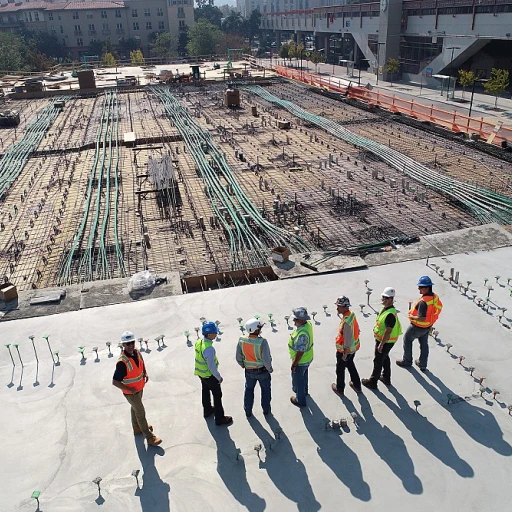
Understanding the Role of an Interview Guide in Tech Hiring
The Significance of Interview Guides in the Tech Hiring Process
Interviewing in the tech industry is a complex undertaking, primarily because the roles are highly specialized and the skills required vary widely from one position to another. Here, a well-crafted interview guide becomes indispensable. It serves as a structured template that helps ensure consistency and thoroughness when assessing candidates during interviews.
By using a structured interview guide, hiring teams can systematically evaluate candidates. This approach allows for the assessment of both technical competences and relevant soft skills, ensuring that interviews are not only about technical prowess but also about cultural fit and teamwork abilities. A solid guide provides a clear process, minimizing biases by focusing on job description and role-specific questions.
Incorporating a range of interview questions and follow-up questions helps dive deeper into a candidate’s capabilities. This step is essential in identifying top talent and making informed hiring decisions. Structured interviews prevent deviations and ensure all candidates experience similar assessment, leading to more reliable outcomes.
Throughout the hiring process, an effective interview guide collects notes and feedback from interviewers, helping refine the hiring strategy over time. It becomes an evolving tool that adapts to the changing demands of specific roles and the needs of the organization.
Ultimately, a meticulously designed interview guide paves the way for achieving satisfactory to excellent recruitment results. It not only streamlines the interview process but also assists in crafting meaningful templates that contribute to hiring efficiency and effectiveness.
Key Components of a Tech Interview Guide
Building a Robust Interview Framework
Crafting an effective tech interview guide demands a structured approach that seamlessly integrates various components. To effectively assess candidates during the recruitment process, it's essential to develop a solid framework which will lay the foundation for a successful interview.- Comprehensive Job Description: Start your guide with a detailed job description. This serves as the cornerstone, providing insight into the role's specific requirements and responsibilities. Ensuring clarity in the role outlined helps tailor relevant interview questions and identify the skills needed from candidates.
- Structured Interview Templates: Utilizing structured interview templates is crucial in maintaining consistency across interviews. These templates help guide the process smoothly and reduce bias, ensuring fair treatment of each candidate. Adjust them to reflect the job's specific requirements.
- Diverse Question Set: Design a comprehensive set of questions that assess both technical skills and soft skills. This balanced approach ensures that the candidate's problem-solving capabilities and interpersonal skills are evaluated. Tailor questions to the specific tech role being filled, allowing for an effective assessment of each interviewee.
- Follow-Up and Probing Questions: Incorporate follow-up questions to gather deeper insights into a candidate's responses. This step helps in clarifying points and assessing the candidate’s problem-solving abilities further. It ensures a complete understanding of the candidate's skills and experiences.
- Detailed Interview Notes: Encourage detailed note-taking during every interview. These notes are invaluable when reviewing the interview process, aiding in making well-informed hiring decisions. Notes help trace back through candidate responses and are essential during discussions with hiring panels.
Tailoring Questions for Different Tech Roles
Adjusting Questions for Role Specificity in the Hiring Process
Creating a structured interview guide requires a keen understanding of how to tailor your questions according to the specific technology roles you are recruiting for. Unique positions necessitate unique lines of inquiry, and the effectiveness of your interview process largely hinges on your ability to delve into the role's specifics.- Role-Specific Inquiries: Begin by aligning your questions with the job description and the essential skills required. For example, an interview template for a software developer role might focus heavily on problem-solving and coding proficiency, while a systems analyst role might prioritize skills in system integration and data processing.
- Evaluate Through Structured Interviews: Structured interviews are integral to maintaining consistency and impartiality. They allow you to compare candidates efficiently by using pre-determined questions that assess both technical and soft skills. This process also helps in identifying top talent by placing emphasis on the key capabilities relevant to the role.
- Template Diversification: Different roles may require distinct interview templates. Customize your guide template to include follow-up questions that assess the depth of a candidate's knowledge and problem-solving approach. Having a varied set of interview templates enables you to better match the interview to the role considerations, ensuring that each candidate is assessed fairly and comprehensively.
- Leverage Guides as a Tool: A well-crafted interview guide not only aids in evaluating candidates but also streamlines the recruitment process by saving time and improving hiring decisions. This comes by ensuring that every interview is grounded in good practices and centered around the role's critical skill set.
Balancing Technical and Soft Skills Evaluation
Finding the Perfect Blend: Technical vs. Soft Skill Evaluation
Crafting an effective interview guide for tech hiring involves more than just assessing technical acumen. Tech roles today require a harmonious blend of both technical and soft skills. Finding the perfect balance can significantly enhance the structured interview process by offering a comprehensive understanding of a candidate's potential fit within the organization. One of the steps in designing a well-rounded interview template is to integrate questions that cover both the technical skills required by the job and the softer skills that dictate how a candidate might navigate workplace challenges. While technical skills demonstrate a candidate's ability to fulfill the specific demands of a role, soft skills such as communication, collaboration, and problem-solving are equally vital. To start, tailor your interview questions to emphasize job-specific technical proficiencies. You might use a structured interview guide to script questions aligned with the technical requirements outlined in your job description. This approach helps ensure that the core functional needs are adequately assessed during the interview. Equally, it's important to incorporate interview templates that evaluate behavioral attributes. For instance, scenarios can be presented to candidates to assess their decision-making capabilities and how they handle teamwork under pressure. This balanced approach allows you to gauge a candidate's potential beyond just their technical qualifications. Taking notes on these different areas can help during the candidate evaluation process. Notes and feedback from interviews can be aggregated to develop a clearer picture of a candidate's overall aptitude, assisting hiring decisions by highlighting strengths and areas of improvement. Best practices suggest preparing a set of follow-up questions to probe further into any interesting or concerning points that arise. Remember, effective interviews should offer insights into both good excellent and satisfactory good candidate attributes. In this crucial hiring step, the goal is to choose the top talent who not only meets the technical benchmarks but also contributes positively to the company culture. A well-rounded approach ensures your recruitment process is thorough and structured, ultimately leading to sound hiring decisions.Utilizing Interview Feedback Effectively
Effective Use of Feedback in Tech Interviews
Incorporating feedback into the tech interview process is a critical step that can significantly improve hiring outcomes. After conducting interviews, it is essential to systematically gather and utilize feedback to refine your hiring strategy and make informed decisions.
Here's how to effectively use feedback in your tech interviews:
- Structured Feedback Collection: Use a structured interview template to ensure that feedback is consistent and covers all necessary aspects of the candidate's performance. This includes both technical skills and soft skills. Structured interviews help in maintaining uniformity across different interviewers and candidates.
- Timely Feedback Compilation: Collect feedback promptly after each interview while the details are fresh in the interviewers' minds. This step ensures that no critical insights are lost over time.
- Comprehensive Notes: Encourage interviewers to take detailed notes during the interview process. These notes can be invaluable in assessing the candidate's problem-solving abilities and how well they fit the specific job role.
- Collaborative Discussion: Organize a debriefing session where all interviewers can discuss their observations and impressions. This collaborative approach allows for a well-rounded assessment of the candidate, considering diverse perspectives.
- Feedback Integration: Use the collected feedback to refine your interview guide and templates. Identify any recurring issues or gaps in the interview questions that need addressing.
- Continuous Improvement: Regularly review and update the interview process based on feedback. This helps in adapting to changing industry standards and ensures that your hiring process remains competitive and effective in attracting top talent.
By leveraging feedback effectively, you can enhance your recruitment strategy and make more informed hiring decisions. This process not only helps in assessing candidates accurately but also in refining the overall interview guide to better suit your organization's needs.



